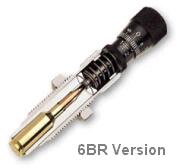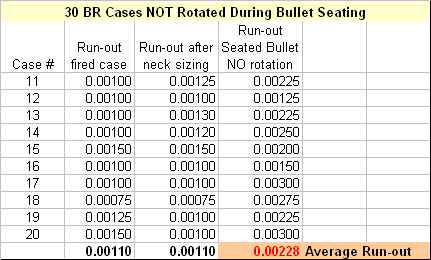Tech Tip: Try Rotating Cartridge During Bullet Seating Process — This Might Reduce Bullet Run-Out
 Here is a simple technique that can potentially help you load straighter ammo, with less run-out. It costs nothing and adds only a few seconds to the time needed to load a cartridge. Next time you’re loading ammo with a threaded (screw-in) seating die, try seating the bullet in two stages. Run the cartridge up in the seating die just enough to seat the bullet half way. Then lower the cartridge and rotate it 180° in the shell-holder. Now raise the cartridge up into the die again and finish seating the bullet.
Here is a simple technique that can potentially help you load straighter ammo, with less run-out. It costs nothing and adds only a few seconds to the time needed to load a cartridge. Next time you’re loading ammo with a threaded (screw-in) seating die, try seating the bullet in two stages. Run the cartridge up in the seating die just enough to seat the bullet half way. Then lower the cartridge and rotate it 180° in the shell-holder. Now raise the cartridge up into the die again and finish seating the bullet.
Steve, aka “Short Range”, one of our Forum members, recently inquired about run-out apparently caused by his bullet-seating process. Steve’s 30BR cases were coming out of his neck-sizer with good concentricity, but the run-out nearly doubled after he seated the bullets. At the suggestion of other Forum members, Steve tried the process of rotating his cartridge while seating his bullet. Steve then measured run-out on his loaded rounds. To his surprise there was a noticeable reduction in run-out on the cases which had been rotated during seating. Steve explains: “For the rounds that I loaded yesterday, I seated the bullet half-way, and turned the round 180 degrees, and finished seating the bullet. That reduced the bullet runout by almost half on most rounds compared to the measurements from the first test.”


Steve recorded run-out measurements on his 30BR brass using both the conventional (one-pass) seating procedure, as well as the two-stage (with 180° rotation) method. Steve’s measurements are collected in the two charts above. As you can see, the run-out was less for the rounds which were rotated during seating. Note, the change is pretty small (less than .001″ on average), but every little bit helps in the accuracy game. If you use a threaded (screw-in) seating die, you might try this two-stage bullet-seating method. Rotating your case in the middle of the seating process won’t cost you a penny, and it just might produce straighter ammo (nothing is guaranteed). If you do NOT see any improvement on the target, you can always go back to seating your bullets in one pass. READ Forum Thread….
Similar Posts:
- Reduce Run-Out — Try Rotating Your Cases During Bullet Seating
- Try Rotating Cases During Bullet Seating to Reduce Run-Out
- For Less Run-Out, Try Rotating Your Cases During Bullet Seating
- For Reduced Runout, Rotate Your Cases During Bullet Seating
- TECH Tip: How to Reduce Run-Out with Seating Dies
Tags: 30BR, bullet, Concentricity, Die, Rotation, Run-Out, Seating Die


















I’ve found that it also seats the bullets more consistant for length and 3 to 5 strokes don’t hurt.
I’ve been seating my bullets by rotating the case in thirds using three strokes of the ram for final seating. I’ve been doing this for years and it does give less runout.
Does it make a difference on the target with such a small improvement as in the posted 30BR example which yielded a .0008 average improvment? Well, you be the judge.
Danny
Yes, several soft strokes while rotating won’t deform the neck, works for me.
GeneD
Float your dies and you should not have any run out.
I rotate 90 degrees. At 180 you stll have the same angle only your top is your bottom. At 90 you fix your side to side as well.
I had a concentricity problem with my Redding Competition die as well. I was getting runouts from .0005-.004. Upon examination I found that the cartridge case wasn’t seating all the way up in to the shoulder of the sliding sleeve of the die with the result that it was loose when the bullet was being seated. allowing the case to move sideways very slightly. This apparently enabled the bullet to enter at a slight angle giving random runout. I considered removing a thou or so from the bottom of the sliding sleeve but decided against it. Instead I checked the heighth of several shellholders with a depth gauge and used the thinnest one I had. Then I set up the die so that the die body bottomed snugly against the shellholder (without a cartridge case) and proceeded to seat some bullets using cases selected with little or no runout using a slow single motion of the press handle. My runout dropped dramatically and now gives me .005-.0015 with Winchester brass and no- turned necks.
EDITOR: Max — that is a clever work-around and a very useful tip. Yet one more possible use for the Redding competition shellholder.
Yes rotating DOES help with run out, i rotate my .308 Win. and usually have .001 to none. Like Dan says 3-5 strokes and rotating everytime makes a big difference.
I’ve always rotated 120 degrees/ 3 turns total. Verified results with the Sinclair gauge & see an improvement.
To the guys who rotate when seating bullets, do you do the same thing with Wilson-style bullet seaters (hand dies)?
Going back to Max Wagner’s post, he is on the money. A precision shortening of the sleeve has worked for years. It also makes the die easy to set up from press to press. Max has done the same thing with the adjustment.
John Whidden went to this sleeve modification on his Dillon presses where he also floated the die plates. He loads very fine ammo with this progressive combo.
queen_stick I rotate using Wilson seating dies.
1st barely getting bullet into neck, then rotate~120, seat half way, rotate 120, then seat fully.
This is a old David Tubb trick
I shoot only silhouette offhand so 1/2 MOA is plenty accurate for me although my 6.5L will do under a 1/4 MOA.
When I am reloading I run the case up until the bullet is in contact with both the top seating die and just inside the case neck. At this point since I already have my fingers right there placing the bullet I’ll give the brass 1/4 to 1/3rd of a turn to center things up that might be crooked. Seems to work like a charm and the few I measured for concentric tolerance were fine. So I just do it and never bother to check how concentric they are anymore. I just run with it.
Honestly. I haven’t found a single load yet in the 6.5L that doesn’t seem to shoot well. Or plenty well for me at least. No one is holding offhand in .1 MOA increments lol.
The shortening of the sleeve does not have to be a precision operation, because after it is completed, you will have created clearance so that it is the case, rather than the shell holder that raises the sleeve in the die body. Also, lowering the body to make slight contact (not to much or the unhardened die body will be deformed) helps with ogive to head consistency. If your case is loose in the bottom of the sleeve, a little “precision blue painters tape” applied so that the ends but, just inside the opening and extending perhaps 3/8″ into the sleeve, can seriously improve the fit, and your results. It is a bit tricky to do, so don’t try it when you are feeling short of patience.